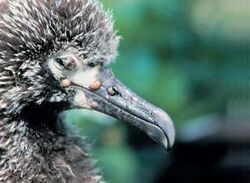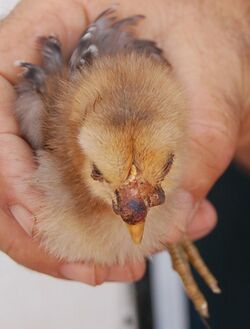Biology:Fowlpox
| Fowlpox virus | |
|---|---|

| |
| Example of clinical signs produced by Fowlpox virus | |
| Virus classification | |
| (unranked): | Virus |
| Realm: | Varidnaviria |
| Kingdom: | Bamfordvirae |
| Phylum: | Nucleocytoviricota |
| Class: | Pokkesviricetes |
| Order: | Chitovirales |
| Family: | Poxviridae |
| Genus: | Avipoxvirus |
| Species: | Fowlpox virus
|
Fowlpox is the worldwide disease of poultry caused by viruses of the family Poxviridae and the genus Avipoxvirus. The viruses causing fowlpox are distinct from one another but antigenically similar, possible hosts including chickens, turkeys, quail, canaries, pigeons, and many other species of birds. There are two forms of the disease. The first (dry form) is spread by biting insects (especially mosquitoes) and wound contamination, and causes lesions on the comb, wattles, and beak. Birds affected by this form usually recover within a few weeks. The second (wet form) is contracted by inhalation or ingestion of the virus via dust (i.e. dander, representing virus-infected cells shed from cutaneous lesions) or aerosols, leading to the 'diphtheritic form' of the disease, in which diphtheritic membranes form in the mouth, pharynx, larynx, and sometimes the trachea. The prognosis for this form is poor.[1]
Fowlpox in chickens
Fowlpox is a common disease in backyard chickens that have not been vaccinated. Most birds survive the infections, although very young or weak birds may be lost. The lesions initially looks like a whitish blister and appear on the comb, wattles and other skin areas. In rare cases lesions can be found on the body, legs and even sometimes the softer parts of the beak. The blisters develop into a dark scab and take about three weeks to heal and drop off. Fowlpox lesions, when in the infected birds mouth and throat can cause difficulty breathing, even death.[2] Scarring may result and consequently exhibition poultry breeders prefer to vaccinate and avoid this disease. Management of the mosquito population can help reduce outbreaks of fowlpox.[citation needed]
Fowlpox has demonstrated the capacity to contain integrated sequence from Reticuloendotheliosis virus (REV).[3] Integrated sequence of REV may contain the complete REV provirus sequence or fragments of genome sequence.[4][5][6] Not all fowlpox isolates contain REV integrates.[7][6] Studies analyzing samples from 50 years ago have detected evidence of REV integrated sequences suggesting the integration of REV may not be a new emergence.[8] Fowlpox with integrated REV sequences have been identified in some live fowlpox vaccine lots, in backyard chickens and in wild birds.[7] Fowlpox infections with integrated REV sequence are linked with the development of lymphoma.[4][9]
Clinical signs
There are 2 types of fowlpox: wet pox and dry pox. In all outbreaks, wart-like lumps are visible on many birds, which is a reliable guide to diagnosis.[10][3][11]
Dry pox is the most common and develops as wart-like eruptions. Fleshy pale lumps form yellow pimples that may enlarge and run together to form masses of yellow crusts. These scabs darken and fall off in about a week. They occur mainly on the comb, wattle and face but can occur on other parts of the body.[10]
Wet pox (diphtheritic) forms as ulcerous cheesy masses in the mouth, nose and sometimes throat areas, which can interfere with eating and breathing. Birds with wet pox can appear unwell and in some cases may die.[10]
Mortality is usually low in affected flocks. Reduced egg production and poor weight gains are the greatest impacts.[10]
Treatment
Vaccines are available for fowlpox (ATCvet code: QI01AD12 (WHO)). Chicken are usually vaccinated with pigeonpox virus. This vaccine is usually given to chickens when between the age of 8–14 weeks of age, via the wing web method of injection. When a bird is given the vaccine they are exposed to a mild version of the active virus, so they should be completely healthy to prevent severe illness.[2] Turkeys are also routinely vaccinated.[12] Once a bird is infected there are no treatments, just preventive measures including the vaccine and mosquito management.[2][13]
See also
- Turkeypox
- Pigeonpox
References
- ↑ Skinner, M.A. (2008). "Fowlpox Virus and Other Avipoxviruses". Encyclopedia of Virology. pp. 274–284. doi:10.1016/B978-012374410-4.00403-9. ISBN 978-0-12-374410-4.
- ↑ 2.0 2.1 2.2 Butcher, Gary D; Rossi, Fred (1996). Prevention and Control of Fowl Pox in Backyard Chicken Flocks. University of Florida Cooperative Extension Service, Institute of Food and Agriculture Sciences, EDIS. OCLC 48524703. https://edis.ifas.ufl.edu/vm021.
- ↑ 3.0 3.1 Zhao, Kui; He, Wenqi; Xie, Shengnan; Song, Deguang; Lu, Huijun; Pan, Wei; Zhou, Ping; Liu, Wenfeng et al. (July 2014). "Highly Pathogenic Fowlpox Virus in Cutaneously Infected Chickens, China". Emerging Infectious Diseases 20 (7): 1208–1210. doi:10.3201/eid2007.131118. PMID 24963887.
- ↑ 4.0 4.1 Koo, B. S.; Lee, H. R.; Jeon, E. O.; Jang, H. S.; Han, M. S.; Min, K. C.; Lee, S. B.; Kim, J. J. et al. (December 2013). "An Outbreak of Lymphomas in a Layer Chicken Flock Previously Infected with Fowlpox Virus Containing Integrated Reticuloendotheliosis Virus". Avian Diseases 57 (4): 812–817. doi:10.1637/10551-041113-Case.R1. PMID 24597128.
- ↑ Singh, Pratik; Schnitzlein, William M.; Tripathy, Deoki N. (15 May 2003). "Reticuloendotheliosis Virus Sequences within the Genomes of Field Strains of Fowlpox Virus Display Variability". Journal of Virology 77 (10): 5855–5862. doi:10.1128/JVI.77.10.5855-5862.2003. PMID 12719579.
- ↑ 6.0 6.1 Davidson, Irit; Shkoda, Irena; Perk, Shimon (1 October 2008). "Integration of the reticuloendotheliosis virus envelope gene into the poultry fowlpox virus genome is not universal". Journal of General Virology 89 (10): 2456–2460. doi:10.1099/vir.0.2008/001313-0. PMID 18796713.
- ↑ 7.0 7.1 Biswas, Sanchay K.; Jana, Chandrakanta; Chand, Karam; Rehman, Waseem; Mondal, Bimalendu (April 2011). "Detection of fowl poxvirus integrated with reticuloendotheliosis virus sequences from an outbreak in backyard chickens in India". Veterinaria Italiana 47 (2): 147–53. PMID 21706467. https://www.izs.it/vet_italiana/2011/47_2/147.pdf.
- ↑ Webb, P. I.; Hays, G. C.; Speakman, J. R.; Racey, P. A. (March 1992). "The functional significance of ventilation frequency, and its relationship to oxygen demand in the resting brown long-eared bat, Plecotus auritus". Journal of Comparative Physiology B 162 (2): 144–147. doi:10.1007/BF00398339. PMID 1592909.
- ↑ Fadly, A. M.; Witter, R. L.; Smith, E. J.; Silva, R. F.; Reed, W. M.; Hoerr, F. J.; Putnam, M. R. (March 1996). "An outbreak of lymphomas in commercial broiler breeder chickens vaccinated with a fowlpox vaccine contaminated with reticuloendotheliosis virus". Avian Pathology 25 (1): 35–47. doi:10.1080/03079459608419118. PMID 18645835.
- ↑ 10.0 10.1 10.2 10.3 "Fowl pox" (in en-AU). Agriculture and Fisheries, Queensland Govt. 14 March 2017. https://www.business.qld.gov.au/industries/farms-fishing-forestry/agriculture/livestock/animal-welfare/pests-diseases-disorders/fowl-pox.
 Text was copied from this source, which is available under a Creative Commons Attribution 4.0 International License.
Text was copied from this source, which is available under a Creative Commons Attribution 4.0 International License.
- ↑ "Poxvirus Diseases | Pox Viruses | CDC". 3 January 2019. https://www.cdc.gov/poxvirus/diseases.html.
- ↑ "Poxviridae". A Concise Review of Veterinary Virology. 2006. http://www.ivis.org/advances/Carter/Part2Chap10/chapter.asp?LA=1.
- ↑ Fowl Pox Vaccine 2023: A Breakthrough in Poultry Health poultrypioneers.net
External links
- Fowlpox - CABI datasheet
- Fowlpox in Chickens and Turkeys - Poultry - MSD Veterinary Manual, Merck & Co., Inc., Rahway, NJ, USA
- Fowlpox at Backyard Poultry, Information and pictures.
- Species Profile - Fowlpox (Avipoxvirus), National Invasive Species Information Center, United States National Agricultural Library. Lists general information and resources for Fowlpox.
Wikidata ☰ Q571218 entry
 |


